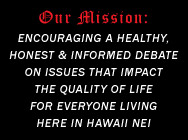

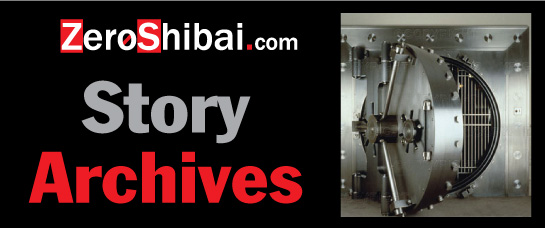
Inspired by State Senator Fred Hemmings' Opening Day Speech Yesterday, a Widely Distributed Anonymous E-mail Causes a Big Stir at State Capitol:
Anonymous Critic of Political Priorities Blitzes State Capitol with Wacky Spam
Published: January 17, 2008

News Coverage of Hemmings' Speech
Click here for the speech which seems to have inspired the cartoonish missive.
Hemmings Lashes Out at Not-So-Anonymous Critic of Shrinking Hawaii GOP
The Danger of Political Short-Sightedness in Hawaii:
How Potential Far Away Events Could Adversely Affect Hawaii and Its People
Published: January 7, 2008
by guest columnist David Wethington | hawaii-dave@hawaii.rr.com
Now that NAFTA has been modified to allow Mexican trucks to travel unrestricted throughout the continental United States the following scenario is not only frightening to contemplate but a very real possibility as well.
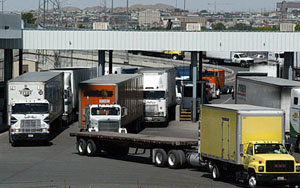 Somewhere in Mexico, three semi-trailer trucks are loaded with goods bound for the United States. the latest government figures show that at most 10 percent of US bound Mexican trucks are inspected at the border. Of those that are inspected, they are given a cursory inspection at best. For this particular example let's say that all three trucks pass through the border without a problem, which is a very real possibility.
Somewhere in Mexico, three semi-trailer trucks are loaded with goods bound for the United States. the latest government figures show that at most 10 percent of US bound Mexican trucks are inspected at the border. Of those that are inspected, they are given a cursory inspection at best. For this particular example let's say that all three trucks pass through the border without a problem, which is a very real possibility.
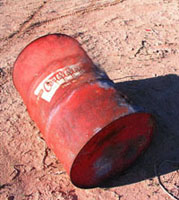 One truck heads for Long Beach, one for San Francisco and the third for Seattle. Within three days all three trucks have reached their destination – the loading docks at the waterfront. Nothing unusual about this, it happens every day. Except this time, things are different. Coordinating their actions by cellphone, the drivers in all three cities position their trucks in the busiest areas next the loading docks. Instead of unloading goods bound for overseas shipment, the tail gate opens and a single 55 gallon drum is pushed out and crashes to the ground. The truck then continues on its way and quickly disappears amongst hundreds of similar looking vehicles. The drivers and their crews abandon the truck and are never found.
One truck heads for Long Beach, one for San Francisco and the third for Seattle. Within three days all three trucks have reached their destination – the loading docks at the waterfront. Nothing unusual about this, it happens every day. Except this time, things are different. Coordinating their actions by cellphone, the drivers in all three cities position their trucks in the busiest areas next the loading docks. Instead of unloading goods bound for overseas shipment, the tail gate opens and a single 55 gallon drum is pushed out and crashes to the ground. The truck then continues on its way and quickly disappears amongst hundreds of similar looking vehicles. The drivers and their crews abandon the truck and are never found.
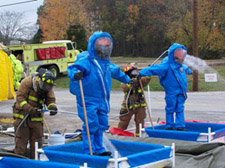 It is soon discovered to the horror of everyone, that the 55 gallon drums that were spilled contained anthrax. Within an hour the FBI, CDC and Homeland Security have descended upon the scenes and the docks are closed. In addition, the local leaders of the dockworkers unions have declared an immediate walk out until further notice. Overseas shipping comes to a sudden and complete stop – similar to the vacant skies after the 9/11 attacks, except this lasts much longer.
It is soon discovered to the horror of everyone, that the 55 gallon drums that were spilled contained anthrax. Within an hour the FBI, CDC and Homeland Security have descended upon the scenes and the docks are closed. In addition, the local leaders of the dockworkers unions have declared an immediate walk out until further notice. Overseas shipping comes to a sudden and complete stop – similar to the vacant skies after the 9/11 attacks, except this lasts much longer.
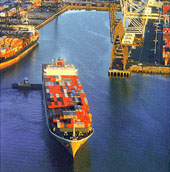 Container ships in port bound for Hawaii are prevented from leaving for fear of importing anthrax into Hawaii. Other ships off the coast waiting to dock are barred from entering the harbors. Fear breeds more fear and false rumors. Days stretch into a week, then two.
Container ships in port bound for Hawaii are prevented from leaving for fear of importing anthrax into Hawaii. Other ships off the coast waiting to dock are barred from entering the harbors. Fear breeds more fear and false rumors. Days stretch into a week, then two.
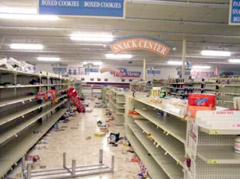 In the meantime, on the day of the attacks, Hawaii residents learn of the docks being closed. They know what this means and they rush to the local supermarkets and 'big box' stores to stock up. Within a few short hours everything edible is gone from the stores. Latecomers are in a panic and it doesn't take long until violence breaks out – food riots, haves vs have nots, armed groups roving the streets looking for food.
In the meantime, on the day of the attacks, Hawaii residents learn of the docks being closed. They know what this means and they rush to the local supermarkets and 'big box' stores to stock up. Within a few short hours everything edible is gone from the stores. Latecomers are in a panic and it doesn't take long until violence breaks out – food riots, haves vs have nots, armed groups roving the streets looking for food.
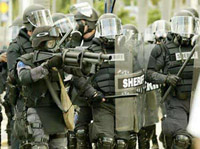 Commerce comes to a grinding halt. Those who are smart and have food stay hidden. Those who do not have food are out looking for it – nothing else matters – money, fancy cars, clothes, they can't be eaten.
Commerce comes to a grinding halt. Those who are smart and have food stay hidden. Those who do not have food are out looking for it – nothing else matters – money, fancy cars, clothes, they can't be eaten.
The local and state governments are of little help. They call out the entire police force and National Guard in an attempt to quell the riots and restore order. For the most part they are unsuccessful. Chaos and fear are in control – fueled by hunger.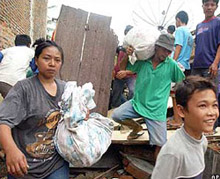
Why all this chaos over a dock closing 2500 miles away? Because Hawaii has at best a 6 day supply of food in the wholesaler's warehouses – if there is no panic! Hawaii's governments at both county and state levels, have for decades stood by and watched local agriculture whither and die. Too many government officials, like many residents, have become addicted to the lifeline from the mainland. Now that the lifeline is cut, panic ensues and people die.
This does not need to happen! There is enough open land on Oahu, Molokai and Lanai that if turned to agricultural use, in time could supply the people of Hawaii with all the food they need. However, growing food takes time. Starting something the day of the West Coast dock closings is obviously far too late.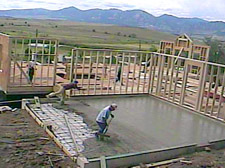
This author has said for decades that Hawaii is making several grave mistakes in our food management: The shackling of local agriculture; the conversion of huge tracts of ag land to residential; the ever growing dependence upon container ships to bring food to Hawaii; and the lack of any plan whatsoever of what to do in an emergency. We have no vast storehouses of food, just a few very vulnerable warehouses that will be exhausted in hours.
In combination, these actions have put Hawaii residents in danger. Only a very few understand this danger, the rest will find out only when their stomachs growl.
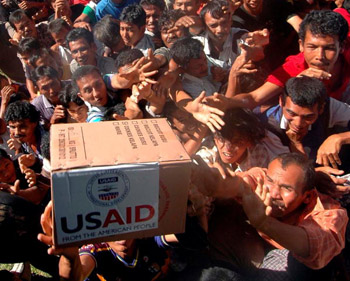 The scenario just described is just one of several that could happen. A bigger terrorist attack involving a multitude of mainland cities or a major earthquake along one of California's many fault lines are just two that quickly come to mind.
The scenario just described is just one of several that could happen. A bigger terrorist attack involving a multitude of mainland cities or a major earthquake along one of California's many fault lines are just two that quickly come to mind.
The time to act is now, before a crisis occurs. Write your elected officials, send them a copy of this article. Urge them to start today to encourage and grow Hawaii agriculture. We simply must have the ability to feed ourselves.
Zero Shibai readers respond to this article
with their thoughtful comments . . .
Sylvia writes: "Excellent article and so true Mr. Wethington. Let's start planning and planting Hawaii!! : )"
HawaiiFarmer writes: "If there is one thing we don't need in Hawaii is more government. All the of the major agriculture infrastructure on every island was done before "more government" by mostly sugar plantations. All government did was tax and restrict. Government can make shipping, for example, more competitive by the elimination of the Jones act. But, the Jones Act remains. It is strictly politics and keeping special interests satisfied. Everytime taxes on farm land increases and government rakes in their spoils, a farmer is eliminated. Everytime government contemplates rules/regulations/penalties to impose on farmers as to what they can/cannot grow more farmers look at building homes on their land and selling their equipment. Farming is tough enough with inadequate infrastructure, unpredictable weather, shipping strikes, disease and pests. Putting up with heavier burdens of government is a death knell. And, in the end, farmers will always know the harsh realty that consumers will pay for what the WANT, not for what they NEED."
![]() Send us your comment on this story
Send us your comment on this story
Honolulu Architects Condemn
Mufi’s Proposed Heavy Rail
“Blight”-Causing Project For Oahu
Published: January 1, 2008
by The Essayists | editor@zeroshibai.com
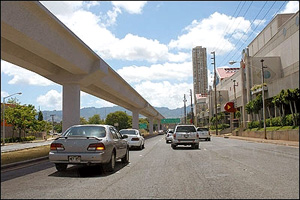 Notwithstanding the humongous payday promised by the largest public works project in Hawaii’s history, Oahu’s architectural community is weighing in against the local political establishment’s wet dream for an above ground heavy rail transit system and its giant elevated train stations along the mammoth route. Click HERE to read the official correspondence from the AIA (American Institute of Architects) Honolulu Chapter to Honolulu’s current Mayor and principal heavy rail advocate Mufi Hannemann. Here are the major points of objection raised by Honolulu’s architects about Mufi’s rail project:
Notwithstanding the humongous payday promised by the largest public works project in Hawaii’s history, Oahu’s architectural community is weighing in against the local political establishment’s wet dream for an above ground heavy rail transit system and its giant elevated train stations along the mammoth route. Click HERE to read the official correspondence from the AIA (American Institute of Architects) Honolulu Chapter to Honolulu’s current Mayor and principal heavy rail advocate Mufi Hannemann. Here are the major points of objection raised by Honolulu’s architects about Mufi’s rail project:
• the project creates adverse effects to our beautiful island
• elevated rail will create a blight, which also obstructs mauka/makai views
• less popular elevated rail desired by Mufi is more expensive than street-level rail
(a.k.a. “at grade” rail)
• development around train stations is much less successful when rail is elevated
versus street-level transit
• examples from San Francisco and Boston illustrate the need to avoid the
expense of getting it wrong the first time rail is implemented (such as
having to subsequently tear down ugly elevated rail systems to replace with
street-level rail)
• industry experts who know the above were ignored by the City and Mufi
told his taxpayer-funded consultants to plan for elevated rail period
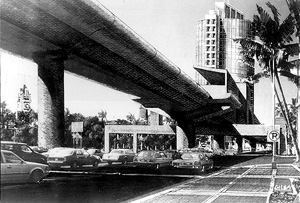 All in all, the letter’s tone is quite tame and provides no basis for any expectation that these visionaries and draftsmen will lay down their slide rules and CAD software long enough to picket in front of Honolulu Hale. After all, a fair share of these same architect and engineer types reportedly participate in Hawaii’s pay-to-play contracting system and certainly all of them need to avoid getting blacklisted so their firms keep getting clients and so their projects receive needed permits. But, make no mistake; they’d rather design buildings and homes for a nice-looking community that retains a special feeling than a concrete jungle resembling the densely constructed, industrial slagheap depicted as our near future living environment in the movie Blade Runner.
All in all, the letter’s tone is quite tame and provides no basis for any expectation that these visionaries and draftsmen will lay down their slide rules and CAD software long enough to picket in front of Honolulu Hale. After all, a fair share of these same architect and engineer types reportedly participate in Hawaii’s pay-to-play contracting system and certainly all of them need to avoid getting blacklisted so their firms keep getting clients and so their projects receive needed permits. But, make no mistake; they’d rather design buildings and homes for a nice-looking community that retains a special feeling than a concrete jungle resembling the densely constructed, industrial slagheap depicted as our near future living environment in the movie Blade Runner.
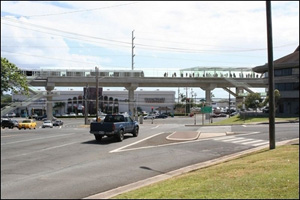 The bottom line is that Mufi, Inouye, Abercrombie, and the rest of the insiders are pushing hard for heavy rail, since that’s what will bring big bucks to their contributors and supporters. On the other hand, the AIA prefers a system that runs at street level, but such an approach has zero hope of being approved since there’s simply no room on Honolulu’s city streets for trains running alongside cars and buses . . . and there's not nearly enough of an opportunity for the well-connected to get rich from light rail as compared to heavy rail. So unless the AIA ramps up the volume of its opposition, their letter to Mufi is just a way for these architects to feel less guilty after Oahu is blighted (and bankrupted) by a train that nobody rides, but everyone will be forced to look at and pay for.
The bottom line is that Mufi, Inouye, Abercrombie, and the rest of the insiders are pushing hard for heavy rail, since that’s what will bring big bucks to their contributors and supporters. On the other hand, the AIA prefers a system that runs at street level, but such an approach has zero hope of being approved since there’s simply no room on Honolulu’s city streets for trains running alongside cars and buses . . . and there's not nearly enough of an opportunity for the well-connected to get rich from light rail as compared to heavy rail. So unless the AIA ramps up the volume of its opposition, their letter to Mufi is just a way for these architects to feel less guilty after Oahu is blighted (and bankrupted) by a train that nobody rides, but everyone will be forced to look at and pay for.
 NOTE: Please understand that “heavy rail” universally means elevated systems made of giant viaducts of concrete and steel, while “light rail” universally refers to at-grade, street-level systems such as street cars, which typically feature train tracks built right into the pavement. Supporters of the proposed $6 billion rail system for Oahu frequently and intentionally misspeak when they describe Mufi’s train project as “light rail” in order to fool the public into thinking the project will be small, unobtrusive and even cheap . . . as things described as "light" usually are. Once built, however, if heavy rail actually comes to Honolulu as proposed, it will be obvious to everyone that Mufi’s Train is anything but “light”. It’ll take a whole new power plant just to run the proposed system, and the amount of concrete and steel required will produce a monstrosity that looks like an entire interstate freeway rather than the cute little cable cars in San Francisco which Tony Bennett sings about.
NOTE: Please understand that “heavy rail” universally means elevated systems made of giant viaducts of concrete and steel, while “light rail” universally refers to at-grade, street-level systems such as street cars, which typically feature train tracks built right into the pavement. Supporters of the proposed $6 billion rail system for Oahu frequently and intentionally misspeak when they describe Mufi’s train project as “light rail” in order to fool the public into thinking the project will be small, unobtrusive and even cheap . . . as things described as "light" usually are. Once built, however, if heavy rail actually comes to Honolulu as proposed, it will be obvious to everyone that Mufi’s Train is anything but “light”. It’ll take a whole new power plant just to run the proposed system, and the amount of concrete and steel required will produce a monstrosity that looks like an entire interstate freeway rather than the cute little cable cars in San Francisco which Tony Bennett sings about.
** Tip of the hat to alert Zero Shibai reader and transportation activist Dale Evans for sharing this letter.
FOR MORE INFORMATION:
Click here for copy of the AIA's Letter to Mayor Mufi Hannemann
http://starbulletin.com/2008/01/02/news/briefs.html
http://honoluluadvertiser.com/apps/pbcs.dll/article?AID=/20080101/NEWS01/801010346/1001
![]() Send us your comment on this story
Send us your comment on this story
Let Them Eat Tourists
Must we have a shipping strike to force us to face Hawaii’s Agriculture Crisis?
Published: December 31, 2007
by The Essayists | editor@zeroshibai.com
Article XI, Section 3, of the Constitution of the State of Hawaii reads:
“The State shall conserve and protect agricultural lands, promote diversified agriculture, increase agricultural self-sufficiency and assure the availability of agriculturally suitable lands.”
Just laid local eggs? Forget it. Fresh milk from contented island cows? No get. How’s the sugar cane and pineapple industry doing?
We used to grow stuff in Hawaii. Big stuff that we shipped around the world, and little stuff, most of which we ate right here. In fact, we Hawaiians grew the best stuff in the world. The best pineapples, sugar, mangoes, papaya, guava – you name it. Still do. And it meant that we were helping to sustain ourselves. Now our farming lands lay fallow, waiting for a zoning change so we can get rich growing houses, with the ever-present risk that any remaining land will be re-zoned for construction. Thanks to the combined anti-agriculture and anti-business forces at work in the Aloha State, an astonishing percentage of that agriculturally zoned land lies barren -- while the few remaining farmers we have, working roughly 5,000 farms, seem to be going out of business almost every day. Now we import roughly 90% of the food we eat.
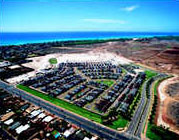 How and why has this happened? Well, being honest, partly because it will be much more profitable sold as housing developments or shopping centers. But it’s also because our local politicians (along with other factors) have made it so darn hard to make any money in agriculture in this state. And eventually we are all going to pay a big price.
How and why has this happened? Well, being honest, partly because it will be much more profitable sold as housing developments or shopping centers. But it’s also because our local politicians (along with other factors) have made it so darn hard to make any money in agriculture in this state. And eventually we are all going to pay a big price.
Now, this is not a call for everyone to go back to the halcyon days before the industrial revolution brought us such evils as electricity, automobiles, air conditioning, flat screen TV’s, Foodland and Sam Choy. We’re not suggesting everyone should be growing their own food in their backyard with handmade shell, rock and koa implements. Most families would starve.
Neither is it a put down of our good, earnest local farmers. We love those weekend Sunshine Markets, both the experience and the food. But frankly, they’re not a serious factor in our state’s economy. And when that next shipping strike hits, they’re only going to feed us for the first 45 minutes before all hell breaks loose. Since there is no agribusiness sector in Hawaii anymore, which sector will we turn to devour? In France, when told the peasants were starving, Marie Antoinette said, “Let them eat cake.” What will be your response, Linda? “Let them eat Tourists?”
No, really, this is a very serious problem. And just as it’s not at all realistic to turn to the farmers markets for self sustainability (or the tourist market), it’s not realistic to expect the problem to be solved simply or immediately. But please . . . let’s begin to think about the issue and look at what can be done.
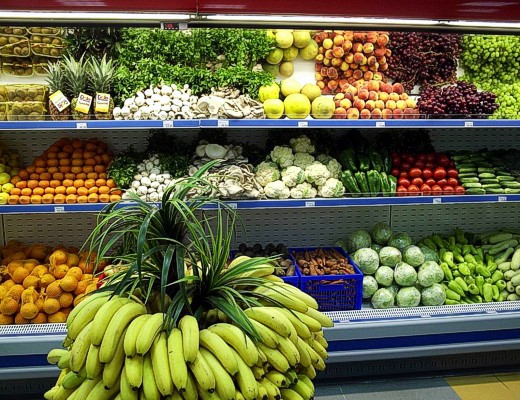 First: Yes, Grandma and Uncle Ito deserve the right to sell that land they’ve worked so long, become developers, have a gated community named after them and retire in luxury . . . just as soon as the land is intelligently rezoned! In the meantime, let’s make it possible for someone to grow something profitably – large or small, for local consumption or export. That means tax breaks, easing of union restrictions, and a huge pile of nicely scissored red tape.
First: Yes, Grandma and Uncle Ito deserve the right to sell that land they’ve worked so long, become developers, have a gated community named after them and retire in luxury . . . just as soon as the land is intelligently rezoned! In the meantime, let’s make it possible for someone to grow something profitably – large or small, for local consumption or export. That means tax breaks, easing of union restrictions, and a huge pile of nicely scissored red tape.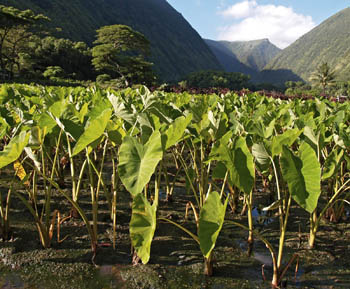
Second: Let’s make it possible to export. That begins with amending The Jones Act. The infamous law known as the Jones Act doesn’t just cripple Hawaiian agribusiness. Ask chicken farmers in North Carolina how bad it hurts. But while we are sympathetic to our Tar Heel cousins: to heck with them. We have problems of our own. Let’s fix it here. Overturning the Jones Act might well be impossible. Maybe even for some legitimate reasons. But fixing the Jones Act with some exceptions for Hawaii is reasonable, doable and necessary. After all, we’re out here on some islands in the middle of the Pacific. We’re pretty vulnerable. Are you listening Neil? Dan 1? Mazie? Dan 2?
 While we’re fixing things, how about fixing some free trade zones in Hawaii . . . say everything west of the H-2. It works for our poor neighbors in NAFTA. Why not a break for our own guys here in Hawaii?
While we’re fixing things, how about fixing some free trade zones in Hawaii . . . say everything west of the H-2. It works for our poor neighbors in NAFTA. Why not a break for our own guys here in Hawaii?
Maybe our state legislature and leaders can put some of the visionary thinking behind the metro rail line to nowhere into some hard core, practical help for farmers and agribusiness that will help us all. While Government looks at the Ewa Plain, for instance, and sees potential tax revenue from hundreds of thousands of new homes, residents, retail taxes, property taxes, gas taxes, air, water, sewer and cost of paradise taxes . . . they might realize that there is not, and never will be, the infrastructure to support a Hawaii that is only a giant housing development surrounded by water. A strong, vibrant and survival-promoting economy always requires more than just housing – and AGRICULTURE is a huge, necessary component.
So good luck, Grandma and Uncle Ito. I hope the new Happy Acres housing development or the Midtown Strip Mall makes you a multigazillionaire. But until it does, can we please plant a small seed and nurture it? Hawaii needs successful, serious agriculture. It would be smart to recognize it, and would be even smarter to start thinking about how to help make it happen now, while we still have some time to chew on the issue . . . and still have something to chew.
In the meantime, anybody know where I can buy one cow and some papaya seeds?
FOR MORE INFORMATION:
http://www.alternative-hawaii.com/agriculture/index.htm
http://www.bizjournals.com/pacific/stories/2007/12/24/daily23.html
http://www.hawaii.gov/hdoa/Info/Statistics/job-opportunities-at-the-hawaii-department-of-agriculture
http://www.honoluluadvertiser.com/apps/pbcs.dll/article?AID=/20071219/NEWS01/712190381/1001/NEWS01
![]() Send us your comment on this story
Send us your comment on this story
Zero Shibai Reader Survey
THE BIG QUESTION FOR YOU:
Updated: December 26, 2007
Q: Why are Hawaii's politicians using all of their federal clout in Washington D.C. in a coordinated strategy to divide people and property along racial lines in our multiethnic paradise, rather than lobbying to end the federal shipping monopoly benefitting Matson and its parent company Alexander & Baldwin by eliminating competition from other shippers -- causing artificially high prices for every Hawaii family and business???
A: Because the existing local shipping monopoly established under the Jones Act financially benefits Hawaii’s political establishment along with business elitists and other insiders -- and the Akaka "Government Reorganization Act" Bill promises do the exact same thing . . . with local folks of all races continuing to get screwed.
Do you agree or disagree?
You've been giving us an EARFUL -- Whew!!
Here are some sample responses from Zero Shibai readers
who've been sending in their thoughtful comments . . .
"I fully agree that the "Jones Act" does nothing more than make the two shipping companies rich while small businesses and people, like you and me, have to pay higher prices for products. If our federal public servants representing Hawai'i on Capitol Hill really wanted to make life and the cost of living easier for all Hawai'i's residents, they'd get rid of this Act once and for all. But since "money talks" with our politicians in Washington, D.C. and our State Legislature, nothing will every be done. The other factor is that the people of Hawai'i grumble about the high cost of living and the "choke-hold" taxes but do nothing to change things. The same b.s. spouting Democrats keep getting reelected in to office without any fear that they'd be "under pressure" to make changes for a better Hawai'i. It's time to go on the "offense" and restore constitutional principles and values in our state and city & county government, it's time to get the People involved in what's going on in their communities and it's time to put the "slick willies" (From both the Democrat and Republican parties) on notice that we're not going to lie down and take the abuse any longer. It's time to take a stand and restore our Hawai'i! ---> submitted by Eric Seabury
"The Jones Act was really ment to hammer Alaska into line so they would be tied to Seattle -- Hawaii was added in. If Matson went out of business because the Jones Act was repealed, Hawaii residents would never know the difference, except the price of goods delivered her would reflect the world shipping costs. Can you imagine goods shipped directly from the source without the extra cost of the US mainland to Hawaii trans-shippment? I can also imagine 20 or so ships in the channel south of Honolulu Harbor busy transferring cargo from one to another, as they do in Singapore. Sadly our governing elite and the folks who fund their election campaigns found a formula that works for them, since we discovered socialism after WWII. Just today I was having coffee at a local Twin-arches fast-food place with some friends and I remarked "these places will become minimum-wage eating places, for the next generation". Those who have access to public sector employment will eventually be forced to take care of their own pay raises and pension enhancements -- the rest of us will be living in "affordable housing" projects or on the beach -- lucky we have such nice weather." ---> submitted by Dennis from Oahu
"In addition to being the land of Aloha, Hawaii is the land of special interests. If you are a regular person just trying to make ends meet you are not of interest to the politicians. If you have your hand out and are of a favored race then the politicians will do anything, including things that are clearly unconstitutional to get your vote or at least to not appear that they do not have compassion for that race. Look at the special interests: Hawaiians, government employees, developers, welfare recipients, Kamehameha schools, politcians in power. Look at those without special interests: everyone else." ---> submitted by Kalli from Oahu
Part One in a Continuing Series
Oahu's Water Supply Going Down the Drain
Will you bet your life on politicians?!?
Published: December 17, 2007
by The Essayists | editor@zeroshibai.com
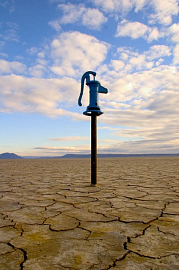 Did you know that in 2005, Senator Akaka and Congressman Abercrombie told the Congress and the President of the United States that Hawaii is going to run out of potable water in 2018? Based upon that, the Congress passed and the President signed the “Hawaiian Water Resources Act of 2005.” Shame on me for not knowing that. For Oahu, the “Act” provides for the Federal Government to pay 25% of the cost of establishing a desalinization capability in the Kapolei area. Are we actively doing anything? Please?
Did you know that in 2005, Senator Akaka and Congressman Abercrombie told the Congress and the President of the United States that Hawaii is going to run out of potable water in 2018? Based upon that, the Congress passed and the President signed the “Hawaiian Water Resources Act of 2005.” Shame on me for not knowing that. For Oahu, the “Act” provides for the Federal Government to pay 25% of the cost of establishing a desalinization capability in the Kapolei area. Are we actively doing anything? Please?
In the first week of October, I attended the “Hawaii Water Works Association (HWWA) Annual Conference. It was attended by experts in all fields related to these water issues. In fact, it was hosted by the Board of Water Supply. Mayor Hannemann was the opening speaker. These are smart, involved, sincere folks. We heard about:
- Conservation, BWS plans and initiatives.
- Innovative water production methods, and an orientation on island hydrology
Amazingly, nothing was said about running out of water in 2018 or the “Act” that is supposed to help Hawaii deal with the situation. Why?
As part of HWWA, Mayor Hannemann introduced the attendees to a very important initiative, the “Hawaii 2050 Sustainability Task Force.” A kick-off meeting of 1000 key personnel was held in September, 2007. Aha! I thought. Surely in such a long range “Sustainability Forum” there would be recognition of our dilemma – running out of potable water in 2018. My optimism was dashed when I “Googled” the “Hawai’i 2050 Sustainability Summit Draft Plan” and the “Hawai’i 2050 Issue Book” that accompanies it. These are key documents from that forum of our best and brightest on the subject. Alas, the first cut is looking like “shelfware.”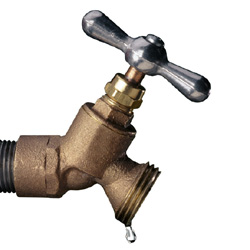
You guessed it! Not a breath about running out of potable water in 2018. Why? Shame on them!! Shame on whom?? Shame on all those who are fully aware of the “Hawaii Water Resources Act of 2005” and apparently didn’t breathe a word of the pending crisis to “Task Force” attendees. Amazingly, a document from this forum even went so far as to say that there is a “relative abundance of water …” (as long as you are willing to pay for it).
Apparently, that was an indirect reference to the demonstration desalinization facility that has been built on the Ewa / Kapolei coast. It produces up to 5 Million GPD, but in the process produces 7 million GPD of chemical brine waste! Wonder what happens to that?
The problem is that the water table has been dropping for decades and is now approaching the lens cap in many of our aquifers that in 2018 (maybe sooner ?) could give us salt water out of our tap. It is simply an issue of ground water supply versus demand. Ground water supply is dropping, while our demand is rising. Though one can trot out statistics on some positive usage trends, the bottom line is whether the water table continues to drop.
A few years back, I clearly remember the Director of BWS, at a Conference, stating twice, that his job was to find more water for the developers. Huh? The crowd did get emotional over that one. I mention that because it provides a context for the “Honolulu-Star Bulletin” insert on Wednesday 26 September, 2007: 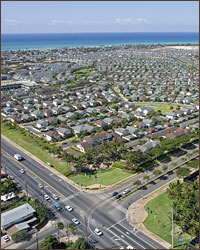
“BOOMTOWN:” an article on growth trends on Oahu. Bottom line is that from 2000 to 2005, the population growth in Mililani was 45.3% (about +5,000). Similarly, the Makakilo/Kapolei areas are on track with 21-22% growth respectively (about +15,100 people) as they expand toward the planned second city on the Western plain of about 60,000? One might assume that the impact on our water resources has been planned out to cover this, if not, might it then be a cause of us running out of water in 2018 (or sooner)?
So where does all of this come together? Who is in charge? Who is responsible and accountable? What are the measurable milestones for avoiding the “shipwreck?” How can we be assured on a routine basis that the right things are happening? The Public must understand that this is not just another political issue. It is all about our life in Hawaii. Never mind worrying about the children, the worst can happen in our lifetime.
No more grand plans on the shelf! Our leadership has been admiring this problem so fundamental to our existence for far too long. Decisive actions must be taken that will actually work, that are laser focused upon true results that actually solve the ground water supply & demand problem, and will stand the test of time.
These actions must transcend individual personalities, elections and politics. They must be durable and have responsibilities and accountability clearly identified. Get involved folks. It is getting late!
FOR MORE INFORMATION:
Click here for complete copy of this article
Also...
Shocking Board of Water Supply Report Reveals Deadly Secret About Oahu's Potable Water:
Even with Improved Conservation Methods, Oahu to RUN OUT of Drinking Water in 2018
. . . JUST TEN YEARS FROM NOW !!!
Hawaii 2050 Sustainability Task Force
Board of Water Supply Homepage (which boasts that "WATER CONSERVATION NO LONGER NECESSARY")
Kailua Guy wrote: "On the water problem - you did not mention the water being diverted from passing through the Waiahole Ditch and kept on the windward side to flow into the ocean. Water that was formerly used for Ag in the central valley. No logic, just Hawaiian appeasement. Surely that water could be captured to replenish the aquifers... I am told that "millions of gallons" are lost, but don't have any perspective to put it into context."
![]() Send us your comment on this story
Send us your comment on this story
Shhhh . . . Hawaii's Politically-Created Shipping Monopoly Makes Everything - Yes, Everything - Way More Expensive
Published: December 17, 2007
by The Essayists | editor@zeroshibai.com
Hawaii is 2,400
miles from the nearest mainland ports. There are, obviously, no rail
lines, pipelines or highways leading from the other 49 states to Hawaii.
In spite of these facts, Hawaii suffers strangulation, suffocation by
being forced to exist under shipping regulations designed to control
COASTAL SHIPPING.
This federal law is known as the Jones Act. The net effect of this law
is the restriction of ships, which may do business in Hawaii to those,
which are American owned, operated and built. Hawaii has two American
companies qualified and who currently serve Hawaii's ports.
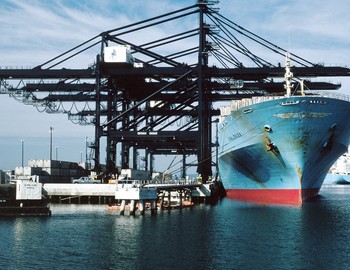 This federal law is known as the Jones Act. The net effect of this law
is the restriction of ships, which may do business in Hawaii to those,
which are American owned, operated and built. Hawaii has two American
companies qualified and who currently serve Hawaii's ports. While two
does not make a monopoly, the net effect on Hawaii's citizens is
monopolistic control of all shipping. Goods from other countries must be
shipped to a port on the West Coast where they can pick up a return
cargo load. Thus, the consumer in Hawaii pays for the double transport
costs and the transshipment of goods.
This federal law is known as the Jones Act. The net effect of this law
is the restriction of ships, which may do business in Hawaii to those,
which are American owned, operated and built. Hawaii has two American
companies qualified and who currently serve Hawaii's ports. While two
does not make a monopoly, the net effect on Hawaii's citizens is
monopolistic control of all shipping. Goods from other countries must be
shipped to a port on the West Coast where they can pick up a return
cargo load. Thus, the consumer in Hawaii pays for the double transport
costs and the transshipment of goods.
Most ships leave Hawaii virtually empty. The consumer at the bottom of
the commercial stream gets stuck with these exorbitant costs. The
fruits, vegetables and all commodities from other countries are more
costly in Hawaii because of this monopolistic control of the shipping
lanes. For the farmer, the rancher, the small businessman, these costs
can mean disaster. In times of drought such as we are now experiencing,
all the products necessary for economic survival must be brought to
Hawaii by ship. A bag of "sweet cob" in Washington State sells for four
to five dollars for 50 pounds. The same bag on Hawaii is twelve dollars
or more.
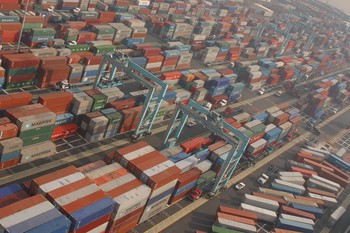
Hawaii's cattle for the most part have to be shipped to Canada on
Canadian ships and then trucked to Oregon or California for fattening.
This makes cattle ranching extraordinarily costly and causes the cost of
local beef to be far higher than on the mainland.
Hawaii's congressional delegation knows these things. They refuse to act
on behalf of the citizenry because they are tied to the special interest
groups who prosper from this absolute control over all products coming
to Hawaii. Alexander and Baldwin had a 160% increase in profits last
year. This at a time when the whole state is in an economic depression.
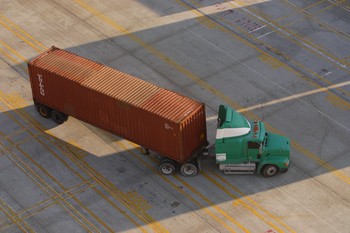
Hawaii's voters must demand that politicians do all in their power to remove the
Draconian restrictions of the federal law from the backs of Hawaii's
people. The results should be a far more healthy economy, many more
markets for Hawaii's products, and an increase in the standard of living
for all of our people. The last nine years have demonstrated that we
cannot exist as a state with little diversification; tourism has become
the primary component of our economy. If that one industry fails, as it
has elsewhere, the results will be truly catastrophic. Aside from
tourism, there are no other primary components with the possible
exceptions of fishing, farming, and ranching. The potential for
encouraging growth in several other sectors definitely exists.
Businesses, farmers, and ranchers pay exorbitant prices for everything
they buy from the mainland because of the virtual monopoly of the
shipping companies. Ships don't crowd our docks. Many shops and stores
are vacant. The most common sight in stores on the Big Island is
"Available for Lease" or "Close Out Sale", "Going Out of Business". Yet,
our congressmen will not budge to get the relief we need for almost all
of our businesses. The owner of one shipping company posted a 160%
profit increase in 1999 while we had over 5000 bankruptcies, numerous
small business failures, and high numbers of welfare recipients. That
profit came from every consumer in this state. We cannot tolerate this
situation any longer!
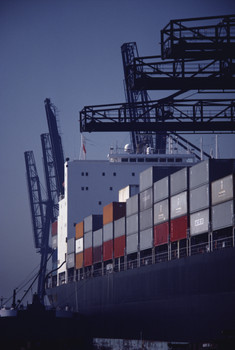
Hawaii was traditionally an agricultural state. Yet, the farmers and
ranchers here get the short end of everything. We have the best climate
in the world; nutrient rich volcanic soil for growing virtually
everything from papaya to artichokes, daikon to mangoes. Our fruits are
among the sweetest and most succulent in the entire world. Yet, our
agricultural exports are close to nil. Why? We have no highways, no
railroad or pipelines connecting us to the mainland. If we had no
shipping restrictions, open ports, in effect, we could cut the cost of
living for everyone. The cost of doing business, of farming, ranching,
and to some extent, fishing, we could accomplish these things, if the
Jones Act did not restrict us.
This law prevents any ships except, for all intents and purposes, those
owned and operated by Matson and Horizon, from docking and unloading
goods in Hawaii. We pay double freight for everything coming in because
we have virtually nothing going out. Has our congressional delegation
tried to get us an exemption from these crushing restrictions? The
answer is no.
This state should have an exemption to these artificial constraints and our leaders must do their best to obtain these long overdue exemptions. Moreover, Hawaii should
have no customs duties in or out. Like Hong Kong before the Communists
took it over, we could be one of the wealthiest states in the entire
union.
FOR MORE INFORMATION:
http://the.honoluluadvertiser.com/article/2006/Jul/10/ln/FP607100337.html
http://starbulletin.com/98/01/07/editorial/smyser.html
http://www.hawaiireporter.com/story.aspx?11dfab6d-fcaa-4a87-be1d-1da7d325dd48
![]() Send us your comment on this story
Send us your comment on this story
This Week's Featured Essay
WHAT? . . . I'm NOT Hawaiian?!?
Published: December 17, 2007
by The Essayists | editor@zeroshibai.com
My wife’s parents came here in 1919 from the Philippines (many of us share a similar story). They had a bunch of children who have served in the Military, the Hawaiian Air Guard, Hawaii National Guard, built homes, had families, and contributed to the culture and the economy. My wife was born in the Territory of Hawaii. One of her daughters teaches our children here in Hawaii. Her grandchildren go to school in Hawaii. When my daughter read the changes that would be wrought by the Akaka Bill, she said, “What? I’m not Hawaiian?!?”
 A friend, a cleric who has devoted his life to ministering to the people of Hawaii (including those inconvenient vows of poverty and chastity), is fifth generation Hawaiian. Oops, I shouldn’t call him “Hawaiian”. He’s fifth generation of a Portuguese family who came to Hawaii in the 19th Century. That family has built businesses, families, homes, and faith in these islands. Presented with the Akaka Bill he asked me, "What? I’m not Hawaiian?!?"
A friend, a cleric who has devoted his life to ministering to the people of Hawaii (including those inconvenient vows of poverty and chastity), is fifth generation Hawaiian. Oops, I shouldn’t call him “Hawaiian”. He’s fifth generation of a Portuguese family who came to Hawaii in the 19th Century. That family has built businesses, families, homes, and faith in these islands. Presented with the Akaka Bill he asked me, "What? I’m not Hawaiian?!?"
A good friend’s family came here in the early 19th Century. People were still living in lava tubes on the Big Island. His ancestors served the Kings and Queens with loyalty and distinction. They served the people of Hawaii, generation after generation. He is Caucasian. Not Haole – for those of you who are completely clueless, Haole means foreigner, not white. According to the Akaka Bill about 80% of this state’s residents are Haoles. My Caucasian friend asks, “If we’re not Hawaiians, what are we? We have nowhere to go. This is our home.”
A Japanese family came here in 1923. They lost a son in the Second World War, fighting for Hawaii, the United States, freedom, tolerance and equality. They lost another son in Korea…fighting for Hawaii, the United States, freedom, tolerance and equality. Ask them where they are from. Ask them where home is. They’ll say Hawaii. What? They’re not Hawaiians?
 I had a long talk with a great guy. “My family get folks from Niihau, li’ dat.” Also, his family can trace its lineage to Bremerhaven, Sapporo, Canton and Bristol. He talked about how his ancestors came here from Tahiti. What extraordinary navigators they were, to sail thousands of miles of ocean in an open sailing canoe to commence a new life on a new island. Of course they had to remove the pesky current inhabitants, a race of small people who seem to have vanished into the historic mists. He called them Menehunes. To the Menehunes, his ancestors were, of course, the absolute worst kind of Haole. But according to the Akaka Bill he is Hawaiian. And entitled to rights, privileges, property and status that nobody mentioned above appears to have earned. How did he earn them? He has a drop of Hawaiian blood.
I had a long talk with a great guy. “My family get folks from Niihau, li’ dat.” Also, his family can trace its lineage to Bremerhaven, Sapporo, Canton and Bristol. He talked about how his ancestors came here from Tahiti. What extraordinary navigators they were, to sail thousands of miles of ocean in an open sailing canoe to commence a new life on a new island. Of course they had to remove the pesky current inhabitants, a race of small people who seem to have vanished into the historic mists. He called them Menehunes. To the Menehunes, his ancestors were, of course, the absolute worst kind of Haole. But according to the Akaka Bill he is Hawaiian. And entitled to rights, privileges, property and status that nobody mentioned above appears to have earned. How did he earn them? He has a drop of Hawaiian blood.
This kind of racial separatism, racial bigotry actually, doesn’t just seem un-American. It seems un-human, un-kind, un-intelligent, un-reasonable and, truthfully, un-Hawaiian. Is there anything in the history of the great people of Hawaii…of King Kamehameha, King Kalakaua, Queen Liliokalani and most especially Pauahi Bishop to countenance this racism, exclusion, or prostitution of the great and noble legacy of fairness, tolerance and equality that defined these islands since unification?
Nope.
No way, brah.
Hawaiian Culture, Tradition and History are not just important. They’re wonderful. Magical. Inspiring. They' have lessons not just for the residents of this fine state, but for America and the whole world. Hawaiian Culture, History and Tradition should be cherished, honored, preserved and shared. And it is – through Hula, music, language, art, crafts, holistic medicine and teaching of philosophy and religion.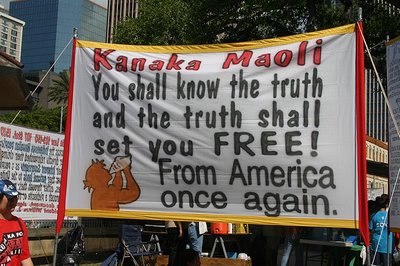
Have you looked for a moment at who is doing that? At who the caretakers, promoters and purveyors of Hawaiian History, Tradition and Culture are? If all of the beautiful, handsome, and talented Filipinos, Samoans, Japanese, Chinese, Portuguese and Caucasian (this list could go on and on) hula dancers and Hawaiian music, arts and crafts artists disappeared, Hula and Hawaiian music would disappear forever..
Check out the people in our Universities teaching and studying (and preserving and promoting) Hawaiian language, history, culture, philosophy and tradition. Think you might find a white guy? Japanese? Chinese mix? Aah... Filipino even?…
Yes, there are wonderful and talented and committed Hawaiian Hawaiian dancers, musicians, academics, healers, teachers, students, artists and archaeologists. Some Hawaiian Hawaiians actually use their talents, gifts and energies in ways not related to Hawaiiana at all…and make significant contributions to our state and the world in doing so.
But the point is: we are all in this together. We are all Hawaiians. We diminish the people of this state…we diminish Hawaiian tradition, teaching and culture…we diminish the importance of what Hawaii can contribute to the world…we diminish every single individual…and we diminish the Hawaiians themselves when we begin to measure a human’s worth by drops of blood. 
This was done before in American. It was called segregation. Every first grader in America knows it was bad. Are we going to prove that the state of Hawaii…that we Hawaiians… are not as smart…are not as spiritually mature… as every first grader in Pocatello, Idaho? Do we need some folks to come down from Birmingham, Alabama and teach us about tolerance?
As Hawaiians (ALL Hawaiians), we have better, more important things to do. An economy to fix. Culture and History to preserve. Beautiful dance, music and art to celebrate.
We are all Hawaiian and it is time to go forward together and make racial separatism a thing of the past . . . permanently.
NOTE: While historians and scientists debate the existence of menehunes, our reference to them is based on literary license to make a point. To be sure, an erudite study by Dr. Yosihiko H. Sinoto, senior researcher for the Bishop Museum, posits that the first inhabitants of these islands were from the Marquesas. Further, Dr. Sinoto’s research reveals that these early inhabitants of Hawaii were later displaced (or driven out) by voyagers from elsewhere in the Polynesian Triangle. But our friends on Kauai are convinced that there were menehunes living in Hawaii long before the Polynesians from Tahiti arrived and took over the islands.
**some of Dr. Sinoto's research is below
FOR MORE INFORMATION:
Polynesian Migration Charts - Bishop Museum
The Prehistory of Polynesia (Part 1 of 2) - Bishop Museum
The Prehistory of Polynesia (Part 2 of 2) - Bishop Museum
http://www.mythicalrealm.com/creatures/menehune.html
http://www.bishopmuseum.org/special/sinoto2006.html
http://www.newsmax.com/archives/articles/2007/7/26/210126.shtml?s=lh
http://starbulletin.com/2006/06/08/news/story02.html
http://hawaiireporter.com/story.aspx?bb41ddce-b172-4d67-969a-4ec752065537
![]() Send us your comment on this story
Send us your comment on this story
DISCLAIMER: All content on this site reflects the opinion of the Essayists and its guest contributors.
Contents are protected speech under the First Amendment to the U.S. Constitution. Mahalo for visiting.